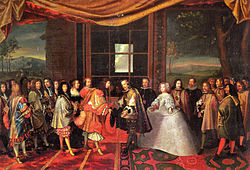Pheasant Island
 | |
| Geography | |
| Location | Bidasoa |
| Area | 0.00682[1] km2 (0.00263 sq mi) |
| Highest elevation | 6 m (20 ft) |
| Administration | |
France (current) | |
| Region | Nouvelle-Aquitaine |
| Département | Pyrénées-Atlantiques |
Spain France | |
| Autonomous community | Basque Country |
| Province | Guipuscoa |
| Demographics | |
| Population | 0 |

Pheasant Island (French: Île des Faisans/Île de la Conférence, Spanish: Isla de los Faisanes, Basque: Konpantzia) is an uninhabited river island in the Bidasoa river, located between France and Spain, whose administration alternates between both nations.
The island is a condominium[2] established by the Treaty of the Pyrenees in 1659, under joint sovereignty of Spain and France, and for alternating periods of six months is officially under the governance of the naval commanders of San Sebastián, Spain (1 February – 31 July) and of Bayonne, France (1 August – 31 January). In practice, it is administered respectively by the mayors of Irun (in Gipuzkoa, Spain) and Hendaye (in the Pyrénées-Atlantiques, France).[3]
Geography[]
As of January 2018, the island is approximately 200 metres (660 ft) long and 40 metres (130 ft) wide, and is eroding.[3]
History[]

The most important historical event to have taken place on the island was the signing of the Treaty of the Pyrenees. This was the climax to a series of 24 conferences held between Luis de Haro, a Grandee of Spain and Cardinal Mazarin, Chief Minister of France, in 1659 following the end of the Thirty Years' War. A monolith was built in the centre of the island to commemorate the meeting.
The island has also been used for several other royal meetings:
- 1659 – Louis XIV met his future wife Maria Theresa of Spain (1638–1683); they were the parents of le Grand Dauphin; a year later – at the Meeting on the Isle of Pheasants – she said farewell to her father, Philip IV of Spain and much of the Spanish court, before crossing into France to become the consort of Louis XIV.
- 1721 – Louis XV met his intended bride Mariana Victoria of Spain (1718–1781). The two never married; Louis instead married Marie Leszczyńska, and Mariana the future Joseph I of Portugal.
Access[]
The island can sometimes be reached from the Spanish side at low tide.[3] It is uninhabited, and access is forbidden[4] except very occasionally on heritage open days.[3] Other than that, employees of the municipal government of Irun or Hendaye may access the island once every six months for cleaning and gardening,[5] and members of the Naval Commands of San Sebastián (Spain) and Bayonne (France), responsible for monitoring the island, will land on it every five days.[5]
See also[]
References[]
- ^ Jannie Wullms (2012). Propuesta de una edición crítica de José de Butrón y Mújica, Relación panegírica de la jornada de los señores, señor don Luis Méndez de Haro y señor cardenal Julio de Mazarino, a la conferencia de los Tratados de la Paz entre el Católico Felipe Cuarto el Grande de España, y el Cristianísimo Luis Catorce de Francia (PDF) (in Spanish). Retrieved 3 December 2015.
- ^ España asume la jurisdicción de la isla de los Faisanes, la más pequeña del mundo (Retrieved 3 December 2015)
- ^ Jump up to: a b c d "The island that switches countries every six months". BBC. 28 January 2018.
- ^ "Pheasant Island". Hendaye Tourist Office. Archived from the original on 13 February 2010. Retrieved 24 January 2012.
- ^ Jump up to: a b Porto, Rita. "A ilha dos Faisões, o condomínio mais antigo do mundo, é seis meses francesa e seis meses espanhola". Observador (in Portuguese). Retrieved 3 February 2019.
External links[]
![]() Media related to Pheasant Island at Wikimedia Commons
Media related to Pheasant Island at Wikimedia Commons
- River islands of Spain
- River islands of France
- Islands of Nouvelle-Aquitaine
- France–Spain border
- Landforms of Pyrénées-Atlantiques
- Irun
- International islands
- Condominia (international law)
- Diplomatic sites
- Landforms of the Basque Country (autonomous community)
